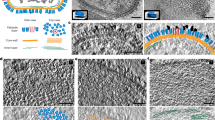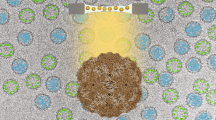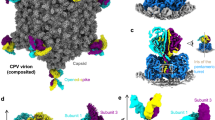Abstract
Cytoplasmic polyhedrosis virus (CPV) is unique within the Reoviridae family in having a turreted single-layer capsid contained within polyhedrin inclusion bodies, yet being fully capable of cell entry and endogenous RNA transcription1,2,3,4. Biochemical data have shown that the amino-terminal 79 residues of the CPV turret protein (TP) is sufficient to bring CPV or engineered proteins into the polyhedrin matrix for micro-encapsulation5,6. Here we report the three-dimensional structure of CPV at 3.88 Å resolution using single-particle cryo-electron microscopy. Our map clearly shows the turns and deep grooves of α-helices, the strand separation in β-sheets, and densities for loops and many bulky side chains; thus permitting atomic model-building effort from cryo-electron microscopy maps. We observed a helix-to-β-hairpin conformational change between the two conformational states of the capsid shell protein in the region directly interacting with genomic RNA. We have also discovered a messenger RNA release hole coupled with the mRNA capping machinery unique to CPV. Furthermore, we have identified the polyhedrin-binding domain, a structure that has potential in nanobiotechnology applications.
This is a preview of subscription content, access via your institution
Access options
Subscribe to this journal
Receive 51 print issues and online access
$199.00 per year
only $3.90 per issue
Buy this article
- Purchase on Springer Link
- Instant access to full article PDF
Prices may be subject to local taxes which are calculated during checkout




Similar content being viewed by others
Accession codes
References
Mertens, P. P. C., Attoui, H., Duncan, R. & Dermody, T. S. in Virus Taxonomy: Eighth Report of the International Committee on Taxonomy of Viruses (eds Fauquet, C. M., Mayo, M. A., Maniloff, J., Desselberger, U. & Ball, L. A.) 447–454 (Elsevier/Academic Press, London, 2005)
Zhou, Z. H. in Segmented Double-Stranded RNA Viruses: Structure and Molecular Biology (ed. Patton, J. T.) 27–43 (Caister Academic Press, Norfolk, 2008)
Hill, C. L. et al. The structure of a cypovirus and the functional organization of dsRNA viruses. Nature Struct. Biol. 6, 565–568 (1999)
Zhang, H. et al. Visualization of protein-RNA interactions in cytoplasmic polyhedrosis virus. J. Virol. 73, 1624–1629 (1999)
Ikeda, K. et al. Immobilization of diverse foreign proteins in viral polyhedra and potential application for protein microarrays. Proteomics 6, 54–66 (2006)
Coulibaly, F. et al. The molecular organization of cypovirus polyhedra. Nature 446, 97–101 (2007)
Grimes, J. M. et al. The atomic structure of the bluetongue virus core. Nature 395, 470–478 (1998)
Reinisch, K. M., Nibert, M. L. & Harrison, S. C. Structure of the reovirus core at 3.6 Å resolution. Nature 404, 960–967 (2000)
Nakagawa, A. et al. The atomic structure of rice dwarf virus reveals the self-assembly mechanism of component proteins. Structure 11, 1227–1238 (2003)
Gouet, P. et al. The highly ordered double-stranded RNA genome of bluetongue virus revealed by crystallography. Cell 97, 481–490 (1999)
Diprose, J. M. et al. Translocation portals for the substrates and products of a viral transcription complex: the bluetongue virus core. EMBO J. 20, 7229–7239 (2001)
Xu, P., Miller, S. E. & Joklik, W. K. Generation of reovirus core-like particles in cells infected with hybrid vaccinia viruses that express genome segments L1, L2, L3, and S2. Virology 197, 726–731 (1993)
Zhou, Z. H., Zhang, H., Jakana, J., Lu, X.-Y. & Zhang, J.-Q. Cytoplasmic polyhedrosis virus structure at 8 Å by electron cryomicroscopy: structural basis of capsid stability and mRNA processing regulation. Structure 11, 651–663 (2003)
Hagiwara, K. & Naitow, H. Assembly into single-shelled virus-like particles by major capsid protein VP1 encoded by genome segment S1 of Bombyx mori cypovirus 1. J. Gen. Virol. 84, 2439–2441 (2003)
Di, X., Sun, Y.-k., McCrae, M. A. & Rossmann, M. G. X-ray powder pattern analysis of cytoplasmic polyhedrosis virus inclusion bodies. Virology 180, 153–158 (1991)
Böttcher, B., Wynne, S. A. & Crowther, R. A. Determination of the fold of the core protein of hepatitis B virus by electron cryomicroscopy. Nature 386, 88–91 (1997)
Henderson, R. The potential and limitations of neutrons, electrons and X-rays for atomic resolution microscopy of unstained biological molecules. Q. Rev. Biophys. 28, 171–193 (1995)
Zhou, Z. H. & Chiu, W. Determination of icosahedral virus structures by electron cryomicroscopy at subnanometer resolution. Adv. Protein Chem. 64, 93–124 (2003)
Inaba, K. et al. Crystal structure of the DsbB-DsbA complex reveals a mechanism of disulfide bond generation. Cell 127, 789–801 (2006)
Jones, T. A., Zou, J. Y., Cowan, S. W. & Kjeldgaard, M. Improved methods for building protein models in electron density maps and the location of errors in these models. Acta Crystallogr. A 47, 110–119 (1991)
Xia, Q., Jakana, J., Zhang, J. Q. & Zhou, Z. H. Structural comparisons of empty and full cytoplasmic polyhedrosis virus: protein-RNA interactions and implications for endogenous RNA transcription mechanism. J. Biol. Chem. 278, 1094–1100 (2003)
Lawton, J. A., Estes, M. K. & Prasad, B. V. Three-dimensional visualization of mRNA release from actively transcribing rotavirus particles. Nature Struct. Biol. 4, 118–121 (1997)
Hakansson, K., Doherty, A. J., Shuman, S. & Wigley, D. B. X-ray crystallography reveals a large conformational change during guanyl transfer by mRNA capping enzymes. Cell 89, 545–553 (1997)
Ikeda, K. et al. Molecular characterization of Bombyx mori cytoplasmic polyhedrosis virus genome segment 4. J. Virol. 75, 988–995 (2001)
Conway, J. F. et al. Visualization of a 4-helix bundle in the hepatitis B virus capsid by cryo-electron microscopy. Nature 386, 91–94 (1997)
Zhang, X. et al. Near-atomic resolution using electron cryomicroscopy and single-particle reconstruction. Proc. Natl Acad. Sci. USA 105, 1867–1872 (2008)
Jiang, W. et al. Backbone structure of the infectious ε15 virus capsid revealed by electron cryomicroscopy. Nature 451, 1130–1134 (2008)
Ludtke, S. J. et al. De novo backbone trace of GroEL from single particle electron cryomicroscopy. Structure 16, 441–448 (2008)
Liang, Y., Ke, E. Y. & Zhou, Z. H. IMIRS: a high-resolution 3D reconstruction package integrated with a relational image database. J. Struct. Biol. 137, 292–304 (2002)
Baker, T. S. & Cheng, R. H. A model-based approach for determining orientations of biological macromolecules imaged by cryoelectron microscopy. J. Struct. Biol. 116, 120–130 (1996)
Crowther, R. A., Amos, L. A., Finch, J. T., DeRosier, D. J. & Klug, A. Three dimensional reconstructions of spherical viruses by Fourier synthesis from electron micrographs. Nature 226, 421–425 (1970)
Crowther, R. A. Procedures for three-dimensional reconstruction of spherical viruses by Fourier synthesis from electron micrographs. Phil. Trans. R. Soc. Lond. B 261, 221–230 (1971)
Liu, H. et al. Symmetry-adapted spherical harmonics method for high-resolution 3D single-particle reconstructions. J. Struct. Biol. 161, 64–73 (2008)
Pettersen, E. F. et al. UCSF Chimera–a visualization system for exploratory research and analysis. J. Comput. Chem. 25, 1605–1612 (2004)
Hagiwara, K. & Matsumoto, T. Nucleotide sequences of genome segments 6 and 7 of Bombyx mori cypovirus 1, encoding the viral structural proteins V4 and V5, respectively. J. Gen. Virol. 81, 1143–1147 (2000)
Kraulis, P. J. MOLSCRIPT: a program to produce both detailed and schematic plots of protein structures. J. Appl. Crystallogr. 24, 946–950 (1991)
DeLano, W. L. The PyMOL User’s Manual (DeLano Scientific, Palo Alto, California, 2002)
Acknowledgements
This research is supported in part by grants from NIH and the Welch Foundation. We are grateful to W. Chiu for his advice and support of this project. We thank Y. Liang, J. Jakana, M. Baker and W. Chiu for their participation at the preliminary stage of this project; J.-Q. Zhang for providing the CPV-containing polyhedra sample; I. Atanasov for assistance during cryo-electron microscopy imaging; X. Zhang for graphics illustration; and P. Lo for reading our manuscript.
Author Contributions X.Y. and Z.H.Z. collected the cryo-electron microscopy data; X.Y. processed the data; L.J. built the models; all authors participated in the structure interpretation and manuscript preparation.
Author information
Authors and Affiliations
Corresponding author
Supplementary information
Supplementary information
The file contains Supplementary Notes, Supplementary Table 1, Legends to Supplementary Movies 1-9 and Supplementary Figures 1-10 with Legends. (PDF 6504 kb)
Supplementary information
The file contains Supplementary Movie 1 showing overall structure of the CPV capsid at 3.88?Å resolution. (AVI 17509 kb)
Supplementary information
The file contains Supplementary Movie 2 showing an extracted helical density from CSP?B superimposed with the C? trace of a standard ??helix, showing the clear turns, the deep grooves and the densities for side?chains revealed by the cryoEM map (AVI 296723 kb)
Supplementary information
The file contains Supplementary Movie 3 showing an extracted density superimposed with the C? traces of CSP?A, showing the separation of the two ? strands. (MPG 36310 kb)
Supplementary information
The file contains Supplementary Movie 4 showing an extracted asymmetric unit from the 3.88?Å resolution density map. (AVI 43247 kb)
Supplementary information
The file contains Supplementary Movie 5 showing density map of CSP?A (blue) and CSP?B (purple) with dsRNA models (red), showing three shallow grooves in the inner sides of both CSP?A and CSP?B. All three grooves are well aligned between CSP?A and CSP?B, forming sliding tracks for RNA. (AVI 15459 kb)
TSupplementary information
The file contains Supplementary Movie 6 showing one TP pentamer (gray), showing that the central chamber of the turret is plugged in by the hemagglutinin?like "A spike" (yellow density). (AVI 41392 kb)
Supplementary information
The file contains Supplementary Movie 7 showing C? models of one CSP?B (cyan), two CSP?As (red and orange), and two GTase domains (blue and light blue), showing the mRNA releasing and capping pathway. (AVI 27212 kb)
Supplementary information
The file contains Supplementary Movie 8 showing Shaded surface representation of TP, showing the two methylase domains (purple), GTase domain (blue), and CPV's unique polyhedrin?binding domain (orange). (AVI 37200 kb)
Supplementary information
The file contains Supplementary Movie 9 showing view of one entire turret, showing the orientation and position of one TP in the turret. (AVI 7379 kb)
Rights and permissions
About this article
Cite this article
Yu, X., Jin, L. & Zhou, Z. 3.88 Å structure of cytoplasmic polyhedrosis virus by cryo-electron microscopy. Nature 453, 415–419 (2008). https://doi.org/10.1038/nature06893
Received:
Accepted:
Published:
Issue Date:
DOI: https://doi.org/10.1038/nature06893
This article is cited by
-
Cryo-EM structure-based selection of computed ligand poses enables design of MTA-synergic PRMT5 inhibitors of better potency
Communications Biology (2022)
-
\({\text{COSNet}}_i\): ComplexOme-Structural Network Interpreter used to study spatial enrichment in metazoan ribosomes
BMC Bioinformatics (2021)
-
Tight junction protein claudin-2 promotes cell entry of Bombyx mori cypovirus
Applied Microbiology and Biotechnology (2021)
-
Assembly intermediates of orthoreovirus captured in the cell
Nature Communications (2020)
-
Electron cryomicroscopy as a powerful tool in biomedical research
Journal of Molecular Medicine (2018)
Comments
By submitting a comment you agree to abide by our Terms and Community Guidelines. If you find something abusive or that does not comply with our terms or guidelines please flag it as inappropriate.



